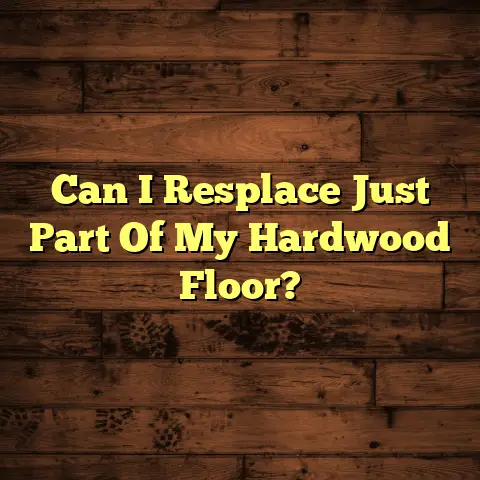Wood Floors: Mix or Match In Your House? (1 Mistake?)
From the classic elegance of oak to the exotic
allure of Brazilian cherry, wood flooring has
always been a top choice for adding warmth and
character to a home.
But times are changing!
Introduction: The Evolution of Wood Flooring
Remember the days when your only real choice was
solid hardwood?
Those days are long gone!
The flooring industry has exploded with
innovation.
We’re talking engineered wood
that’s more stable and resistant to moisture,
sustainable sourcing practices that protect
our forests, and advanced finishes that can
withstand even the toughest wear and tear.
These advancements have opened up a whole new
world of design possibilities, including the
growing trend of mixing and matching wood floors
in different areas of the home.
It’s like
being an artist with a palette of wood, creating
a masterpiece under your feet.
But is it right for you?
And what’s the ONE
mistake that can turn your design dream into a
flooring nightmare?
Let’s dive in!
Section 1: The Art of Wood Flooring
Think of wood flooring as more than just a surface
to walk on.
It’s an artistic element that can
define the entire mood of a room.
Species, Color, and Texture: The Holy Trinity
The variety of wood species available today is
staggering.
You’ve got your classic oaks and
maples, your rich walnuts and cherries, and your
exotic imports like bamboo and acacia.
Each species has its own unique grain pattern,
color variation, and hardness rating, which
affects its durability and how it feels underfoot.
For example:
Oak: A timeless choice, known for its durability and versatility.
Red oak has a pinkish hue, while white oak is more neutral.
According to the National Wood Flooring Association (NWFA), oak is the most popular hardwood flooring choice in the US.Maple: A lighter-colored wood with a subtle grain pattern, perfect for modern spaces.
It’s also very hard and resistant to scratches.Walnut: A luxurious dark wood with a rich, chocolatey color.
It adds warmth and sophistication to any room.-
Hickory: Known for its strength and rustic appeal, hickory features dramatic color variations and a prominent grain pattern.
How Different Woods Evoke Different Feelings
The type of wood you choose can dramatically impact the atmosphere of a space.
-
Light Woods (like maple or birch): Create a bright, airy, and modern feel.
-
Dark Woods (like walnut or mahogany): Add warmth, richness, and a sense of formality.
-
Rustic Woods (like reclaimed pine or hickory): Evoke a sense of history, character, and natural beauty.
Creating Visual Interest with Contrast
One of my favorite tricks is to use contrasting wood styles to create visual interest.
Imagine a light oak floor in the main living areas
paired with a dark walnut floor in the adjacent
dining room.
The contrast defines the spaces and
adds a touch of drama.
Or consider using different patterns, like a herringbone pattern in the entryway and wide planks in the bedrooms.
Section 2: Mixing Wood Floors – A Growing Trend
Mixing wood floors isn’t just a fad; it’s a design
statement!
It’s a way to personalize your home
and create a truly unique look.
Popular Combinations That Work
I’ve seen some fantastic combinations over the
years.
Here are a few of my favorites:
-
Light Oak and Dark Walnut: A classic contrast that works in almost any style of home.
-
Gray-Toned Wood and Natural Wood: A modern combination that adds depth and dimension.
-
Wide Planks and Herringbone: A mix of scale and pattern that creates visual interest.
-
Reclaimed Wood and New Wood: A blend of old and new that adds character and history.
Defining Spaces in Open Floor Plans
One of the biggest benefits of mixing wood floors is that it can help define separate spaces within an open floor plan.
For example, you could use a different wood floor
in the kitchen to visually separate it from the
living room.
Or you could use a different wood
floor in the entryway to create a distinct
sense of arrival.
Case Studies: Mixing Wood Floors Done Right
Let me share a couple of real-world examples:
The Modern Farmhouse: I worked on a project where we used wide-plank, light-toned wood floors throughout the main living areas.
Then, in the home office, we installed a darker, more formal wood floor to create a sense of focus and privacy.The Urban Loft: In a downtown loft, we used reclaimed wood floors in the living room to add character and history.
In the bedroom, we installed a sleek, modern wood floor to create a more calming and contemporary vibe.
Section 3: Matching Wood Floors – A Classic Approach
While mixing wood floors is a hot trend, matching wood floors throughout a home is still a classic and timeless approach.
The Benefits of a Unified Look
There’s something to be said for the simplicity
and elegance of a unified look.
Matching wood
floors create a sense of flow and continuity,
making your home feel more spacious and cohesive.
Psychological Effects of Consistency
Consistency in flooring can also have a positive
psychological effect.
It creates a sense of
harmony and balance, which can be especially
important in today’s chaotic world.
Traditional Homes That Thrive on Consistency
Think of traditional homes with their gleaming
hardwood floors that stretch from room to room.
This consistency enhances their character and
creates a sense of timeless elegance.
Section 4: The One Mistake to Avoid
Alright, let’s get down to brass tacks.
You can mix and match to your heart’s content,
but there’s ONE mistake that can ruin the whole
effect:
Failing to Consider Scale, Grain, and Finish
That’s it!
It sounds simple, but it’s the key to
success.
If you don’t pay attention to these
three elements, your mixed wood floors will look
like a mismatched mess.
Common Pitfalls and How to Avoid Them
Mismatched Undertones: This is the most common mistake I see.
If you pair a wood with warm undertones (like red oak) with a wood with cool undertones (like gray-toned maple), they’ll clash.Solution: Choose woods with similar undertones, or at least complementary ones.
-
Clashing Styles: Pairing a rustic, hand-scraped wood with a sleek, modern wood can look jarring.
Solution: Stick to woods that share a similar aesthetic, or use them in distinctly separate areas.
-
Inconsistent Finishes: If one wood has a high-gloss finish and another has a matte finish, they’ll look out of place together.
Solution: Choose finishes that complement each other, or use the same finish on all of your wood floors.
-
Ignoring Grain Pattern: Pairing woods with wildly different grain patterns can create a busy, chaotic look.
Solution: Balance a wood with a strong grain pattern with a wood that has a more subtle grain.
Section 5: Practical Considerations for Mixing and Matching
Before you start ripping up your floors, let’s talk about some practical considerations.
Size of the Space
In smaller spaces, I generally recommend sticking to a single wood floor to avoid making the space feel even smaller and more cluttered.
In larger spaces, you have more freedom to mix and match, but it’s still important to maintain a sense of balance and harmony.
Lighting
Natural and artificial lighting can significantly affect how wood floors look.
Woods that appear warm and inviting in natural
light may look dull and lifeless under artificial
light.
Be sure to consider the lighting in your
home when choosing your wood floors.
Existing Furniture and Architectural Elements
Your existing furniture and architectural elements should also influence your flooring choices.
If you have a lot of dark furniture, you might
want to choose lighter wood floors to create
contrast.
If you have a lot of natural wood
trim, you might want to choose wood floors that
complement the trim.
Tips on Selecting Wood Floors That Work Well Together
-
Start with a Dominant Wood: Choose one wood that you love and use it as the base for your design.
-
Consider the Undertones: As I mentioned earlier, make sure the woods you choose have similar or complementary undertones.
-
Pay Attention to Grain Pattern: Balance a wood with a strong grain pattern with a wood that has a more subtle grain.
-
Choose Complementary Finishes: Select finishes that complement each other, or use the same finish on all of your wood floors.
-
Test Samples in Your Home: Before you commit to anything, order samples of the wood floors you’re considering and test them in your home under different lighting conditions.
Section 6: Expert Opinions
I’m not the only one with thoughts on this.
Let’s hear from some other experts in the field:
Interior Designers Weigh In
“Mixing wood floors can be a fantastic way to add
personality and visual interest to a home,” says
Sarah Miller, a renowned interior designer.
“But
it’s crucial to have a clear vision and to pay
attention to the details.
The key is to create a
sense of intentionality, not randomness.”
“I often advise my clients to choose a dominant
wood and then use other woods as accents,” adds
John Anderson, another leading designer.
“This
helps to create a cohesive look while still
allowing for some variation.”
Flooring Experts Share Their Insights
“From a practical standpoint, it’s important to
consider the hardness rating of the woods you’re
mixing,” says Mark Johnson, a flooring
specialist.
“If you’re using different woods in
high-traffic areas, you’ll want to make sure
they’re all durable enough to withstand the wear
and tear.”
“I also recommend using the same subfloor
preparation techniques for all of your wood
floors,” adds Lisa Brown, another flooring
expert.
“This will help to ensure that they’re
all installed properly and that they’ll last for
years to come.”
Conclusion
So, there you have it!
Mixing or matching wood
floors is a big decision, but it’s also an
opportunity to express your personal style and
create a home that you truly love.
The most important thing is to choose wood floors
that you find beautiful and that make you feel
good.
Whether you prefer the classic elegance of
matching wood floors or the bold creativity of
mixed wood floors, the choice is yours.
Just remember that ONE mistake to avoid: failing to consider the scale, grain, and finish of your wood floors.
Ultimately, your home should be a reflection of
your unique tastes and preferences.
So, go ahead
and experiment with different wood floors until
you find the perfect combination for your space.
After all, it’s your home, and you should feel
amazing in it!
Happy flooring!
FAQ Section:
Q: Can I mix solid hardwood with engineered wood?
A: Yes, you can, but it’s important to ensure that they have the same thickness to avoid uneven transitions.
Q: Is it okay to mix different widths of wood planks?
A: Absolutely!
Mixing plank widths can add visual
interest and create a more custom look.
Q: How do I maintain mixed wood floors?
A: The maintenance will depend on the finishes
used.
Generally, regular sweeping and occasional
damp mopping with a wood floor cleaner are
sufficient.
Glossary of Terminology:
-
Engineered Wood: A type of wood flooring made from multiple layers of wood veneer bonded together.
-
Hardwood: Wood flooring made from solid pieces of wood.
-
Grain Pattern: The natural pattern of the wood fibers.
-
Undertones: The subtle colors that lie beneath the surface of the wood.
-
Finish: The protective coating applied to the surface of the wood.
-
Herringbone: A pattern created by arranging rectangular wood planks in a zigzag pattern.





